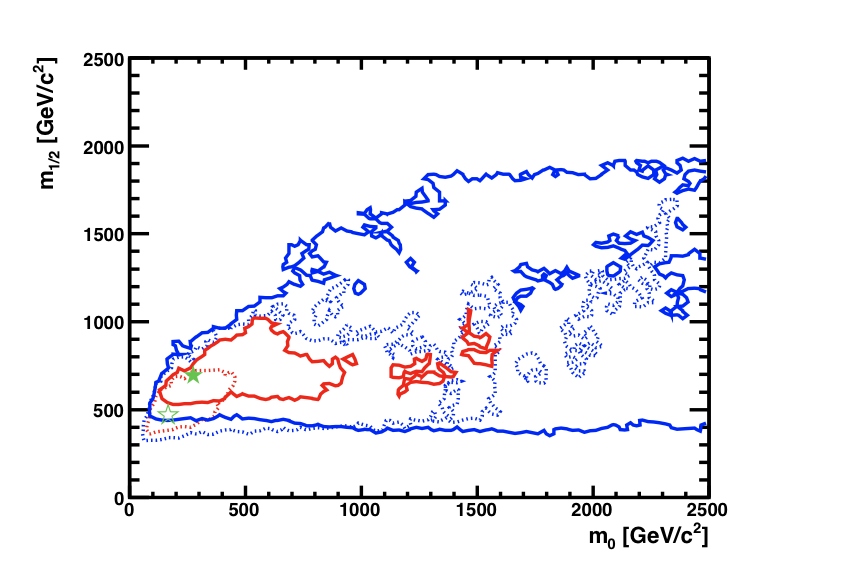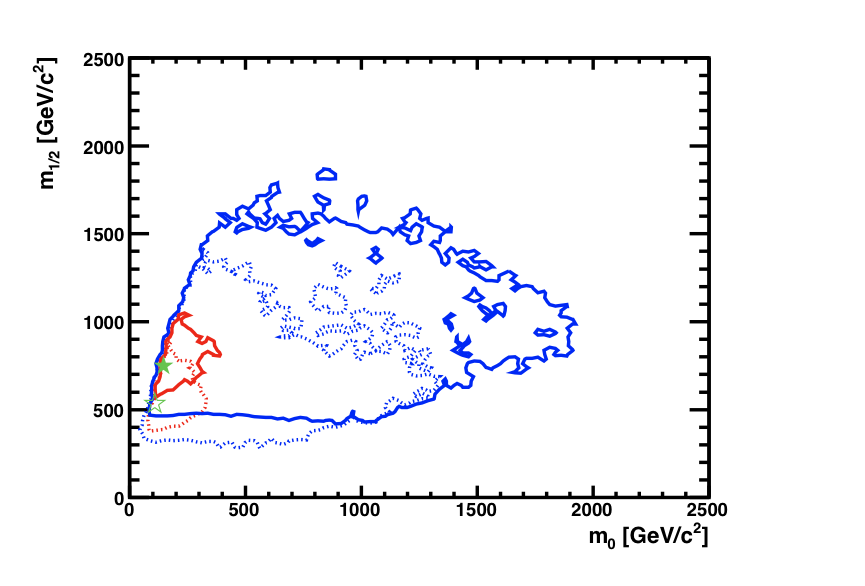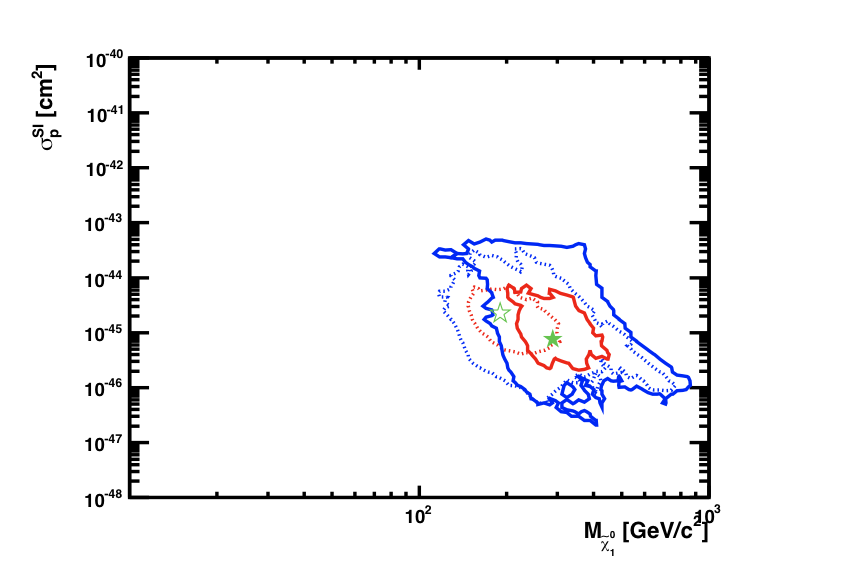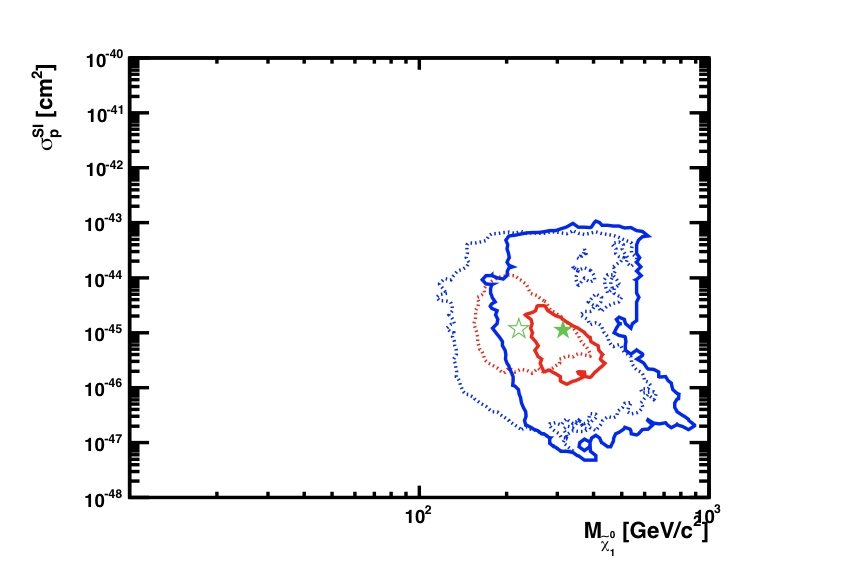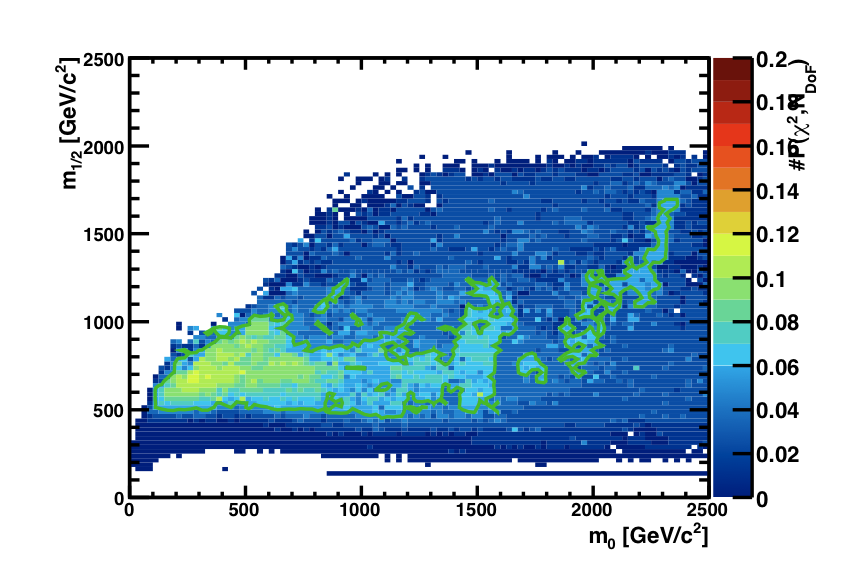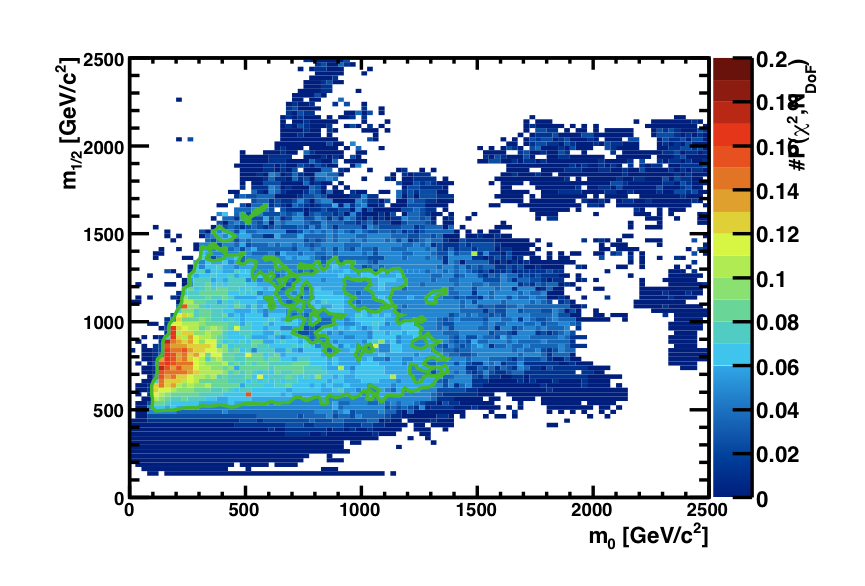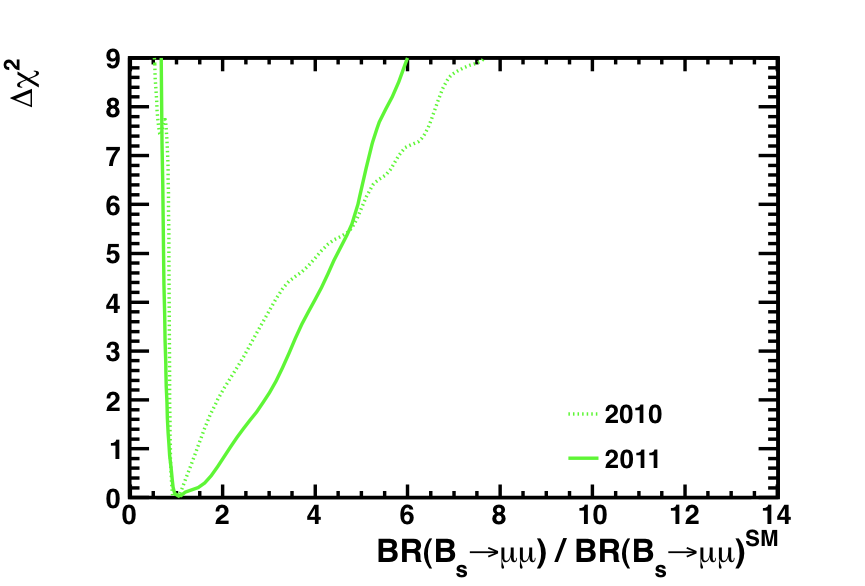News
Global Analysis of Dark Matter Simplified Models with Leptophobic Spin-One Mediators using MasterCode [May 2, 2019]
We report the results of a global analysis of dark matter simplified models (DMSMs) with leptophobic mediator particles of spin one, considering the cases of both vector and axial-vector interactions with dark matter (DM) particles and quarks. We require the DMSMs to provide all the cosmological DM density indicated by Planck and other observations, and we impose the upper limits on spin-independent and -dependent scattering from direct DM search experiments. We also impose all relevant LHC constraints from searches for monojet events and measurements of the dijet mass spectrum. We model the likelihood functions for all the constraints and combine them within the MasterCode framework, and probe the full DMSM parameter spaces by scanning over the mediator and DM masses and couplings, not fixing any of the model parameters. We find, in general, two allowed regions of the parameter spaces: one in which the mediator couplings to Standard Model (SM) and DM particles may be comparable to those in the SM and the cosmological DM density is reached via resonant annihilation, and one in which the mediator couplings to quarks are ≲10
−3 and DM annihilation is non-resonant. We find that the DM and mediator masses may well lie within the ranges accessible to LHC experiments. We also present predictions for spin-independent and -dependent DM scattering, and present specific results for ranges of the DM couplings that may be favoured in ultraviolet completions of the DMSMs.
Full text at
arXiv:1905.00892 [hep-ph].
Likelihood Analysis of the Sub-GUT MSSM in Light of LHC 13-TeV Data [Nov 1, 2017]
We describe a likelihood analysis using MasterCode of variants of the MSSM in which the soft supersymmetry-breaking parameters are assumed to have universal values at some scale M
in below the supersymmetric grand unification scale M
GUT, as can occur in mirage mediation and other models. In addition to M
in, such `sub-GUT' models have the 4 parameters of the CMSSM, namely a common gaugino mass m
1/2, a common soft supersymmetry-breaking scalar mass m
0, a common trilinear mixing parameter A and the ratio of MSSM Higgs vevs tan
β, assuming that the Higgs mixing parameter μ>0. We take into account constraints on strongly- and electroweakly-interacting sparticles from ∼36/fb of LHC data at 13 TeV and the LUX and 2017 PICO, XENON1T and PandaX-II searches for dark matter scattering, in addition to the previous LHC and dark matter constraints as well as full sets of flavour and electroweak constraints. We find a preference for M
in∼10
5 to 10
9 GeV, with M
in∼M
GUT disfavoured by Δχ
2 ∼ 3 due to the BR(B
s,d→μ
+μ
−) constraint. The lower limits on strongly-interacting sparticles are largely determined by LHC searches, and similar to those in the CMSSM. We find a preference for the LSP to be a Bino or Higgsino with
˜χ
01~1 TeV, with annihilation via heavy Higgs bosons H/A and stop coannihilation, or chargino coannihilation, bringing the cold dark matter density into the cosmological range. We find that spin-independent dark matter scattering is likely to be within reach of the planned LUX-Zeplin and XENONnT experiments. We probe the impact of the (g−2)
μ constraint, finding similar results whether or not it is included.

|
| Two-dimensional profile likelihood function for the nominal value of σpSI calculated using the SSARD code in the (mχ,σpSI) plane, displaying also the upper limits established by the LUX, XENON1T and PandaX-II Collaborations shown as solid black, blue and green contours, respectively. The projected future 90% CL sensitivities of the LUX-Zeplin (LZ) and XENON1T/nT experiments are shown as dashed magenta and blue lines, respectively, and the neutrino background ‘floor’ is shown as a dashed orange line with yellow shading below. |
The contour data for this plane and the SLHA files for our benchmark points can be obtained from
here.
Full text at
arXiv:1711.00458 [hep-ph].
Likelihood Analysis of the pMSSM11 in Light of LHC 13-TeV Data [Oct 30, 2017]
We use MasterCode to perform a frequentist analysis of the constraints on a phenomenological MSSM model with 11 parameters, the pMSSM11, including constraints from ~ 36/fb of LHC data at 13 TeV and PICO, XENON1T and PandaX-II searches for dark matter scattering, as well as previous accelerator and astrophysical measurements, presenting fits both with and without the (g−2)
μ constraint. The pMSSM11 is specified by the following parameters: 3 gaugino masses M
1,2,3, a common mass for the first-and second-generation squarks m
˜q and a distinct third-generation squark mass m
˜q3, a common mass for the first-and second-generation sleptons m
˜l and a distinct third-generation slepton mass m
˜τ, a common trilinear mixing parameter A, the Higgs mixing parameter μ, the pseudoscalar Higgs mass M
A and tan
β. In the fit including (g−2)
μ, a Bino-like
˜χ
10 is preferred, whereas a Higgsino-like
˜χ
10 is favoured when the (g−2)
μ constraint is dropped. We identify the mechanisms that operate in different regions of the pMSSM11 parameter space to bring the relic density of the lightest neutralino,
˜χ
10, into the range indicated by cosmological data. In the fit including (g−2)
μ, coannihilations with
˜χ
20 and the Wino-like
˜χ
1± or with nearly-degenerate first- and second-generation sleptons are favoured, whereas coannihilations with the
˜χ
20 and the Higgsino-like
˜χ
1± or with first- and second-generation squarks may be important when the (g−2)
μ constraint is dropped. Prospects remain for discovering strongly-interacting sparticles at the LHC as well as for discovering electroweakly-interacting sparticles at a future linear e+e− collider such as the ILC or CLIC.
The SLHA files of our benchmark points can be obtained from
here.
Full text at
arXiv:1710.11091 [hep-ph].
Likelihood Analysis of the Minimal AMSB Model [Dec 15, 2016]
We perform a likelihood analysis of the minimal Anomaly-Mediated Supersymmetry Breaking (mAMSB) model using constraints from cosmology and accelerator experiments. We find that a wino-like or a Higgsino-like neutralino LSP, m
χ~01, may provide the cold dark matter (DM) with similar likelihood. The upper limit on the DM density from Planck and other experiments enforces m
χ~01≲3 TeV after the inclusion of Sommerfeld enhancement in its annihilations. If most of the cold DM density is provided by the χ
~01, the measured value of the Higgs mass favours a limited range of tan
β∼5 (or for μ>0, tan
β∼45) but the scalar mass m
0 is poorly constrained. In the wino-LSP case, m
3/2 is constrained to about 900 TeV and m
χ~01 to 2.9±0.1 TeV, whereas in the Higgsino-LSP case m
3/2 has just a lower limit ≳650TeV (≳480TeV) and m
χ~01 is constrained to 1.12 (1.13)±0.02 TeV in the μ>0 (μ<0) scenario. In neither case can the anomalous magnetic moment of the muon, (g−2)
μ, be improved significantly relative to its Standard Model (SM) value, nor do flavour measurements constrain the model significantly, and there are poor prospects for discovering supersymmetric particles at the LHC, {though there} are some prospects for direct DM detection. On the other hand, if the m
χ~01 contributes only a fraction of the cold DM density, future LHC ET-based searches for gluinos, squarks and heavier chargino and neutralino states as well as disappearing track searches in the wino-like LSP region will be relevant, and interference effects enable BR(B
s,d→μ
+μ
−) to agree with the data better than in the SM in the case of wino-like DM with μ>0.
The SLHA files of our benchmark points can be obtained from here:
Full text at
arXiv:1612.05210 [hep-ph].
Likelihood Analysis of Supersymmetric SU(5) GUTs [Oct 31, 2016]
We perform a likelihood analysis of the constraints from accelerator experiments and astrophysical observations on supersymmetric (SUSY) models with SU(5) boundary conditions on soft SUSY-breaking parameters at the GUT scale. The parameter space of the models studied has 7 parameters: a universal gaugino mass m
1/2, distinct masses for the scalar partners of matter fermions in five- and ten-dimensional representations of SU(5), m
5 and m
10, and for the 5 and 5¯ Higgs representations m
Hu and m
Hd, a universal trilinear soft SUSY-breaking parameter A
0, and the ratio of Higgs vevs tan
β. In addition to previous constraints from direct sparticle searches, low-energy and flavour observables, we incorporate constraints based on preliminary results from 13 TeV LHC searches for jets + MET events and long-lived particles, as well as the latest PandaX-II and LUX searches for direct Dark Matter detection. In addition to previously-identified mechanisms for bringing the supersymmetric relic density into the range allowed by cosmology, we identify a novel u
~R/c
~R−χ
~01 coannihilation mechanism that appears in the supersymmetric SU(5) GUT model and discuss the role of ν
~τ coannihilation. We find complementarity between the prospects for direct Dark Matter detection and SUSY searches at the LHC.
The SLHA files of our benchmark points can be obtained from here:
Full text at
arXiv:1610.10084 [hep-ph].
Supersymmetric Dark Matter after LHC Run 1 [Aug 5, 2015]
Different mechanisms operate in various regions of the MSSM parameter space to bring the relic density of the lightest neutralino, neutralino_1, assumed here to be the LSP and thus the Dark Matter (DM) particle, into the range allowed by astrophysics and cosmology. These mechanisms include coannihilation with some nearly-degenerate next-to-lightest supersymmetric particle (NLSP) such as the lighter stau (stau_1), stop (stop_1) or chargino (chargino_1), resonant annihilation via direct-channel heavy Higgs bosons H/A, the light Higgs boson h or the Z boson, and enhanced annihilation via a larger Higgsino component of the LSP in the focus-point region. These mechanisms typically select lower-dimensional subspaces in MSSM scenarios such as the CMSSM, NUHM1, NUHM2 and pMSSM10. We analyze how future LHC and direct DM searches can complement each other in the exploration of the different DM mechanisms within these scenarios. We find that the stau_1 coannihilation regions of the CMSSM, NUHM1, NUHM2 can largely be explored at the LHC via searches for missing E_T events and long-lived charged particles, whereas their H/A funnel, focus-point and chargino_1 coannihilation regions can largely be explored by the LZ and Darwin DM direct detection experiments. We find that the dominant DM mechanism in our pMSSM10 analysis is chargino_1 coannihilation: {parts of its parameter space can be explored by the LHC, and a larger portion by future direct DM searches.
Full text at
arXiv:1508.01173
The pMSSM10 prior to LHC RUN II [Apr 13, 2015]
We present a frequentist analysis of the parameter space of the pMSSM10, in which the following 10 soft SUSY-breaking parameters are specified independently at the mean scalar top mass scale Msusy = Sqrt[M_stop1 M_stop2]: the gaugino masses M_{1,2,3}, the 1st-and 2nd-generation squark masses M_squ1 = M_squ2, the third-generation squark mass M_squ3, a common slepton mass M_slep and a common trilinear mixing parameter A, the Higgs mixing parameter mu, the pseudoscalar Higgs mass M_A and tan beta. We use the MultiNest sampling algorithm with 1.2 x 10^9 points to sample the pMSSM10 parameter space. A dedicated study shows that the sensitivities to strongly-interacting SUSY masses of ATLAS and CMS searches for jets, leptons + MET signals depend only weakly on many of the other pMSSM10 parameters. With the aid of the Atom and Scorpion codes, we also implement the LHC searches for EW-interacting sparticles and light stops, so as to confront the pMSSM10 parameter space with all relevant SUSY searches. In addition, our analysis includes Higgs mass and rate measurements using the HiggsSignals code, SUSY Higgs exclusion bounds, the measurements B-physics observables, EW precision observables, the CDM density and searches for spin-independent DM scattering. We show that the pMSSM10 is able to provide a SUSY interpretation of (g-2)_mu, unlike the CMSSM, NUHM1 and NUHM2. As a result, we find (omitting Higgs rates) that the minimum chi^2/dof = 20.5/18 in the pMSSM10, corresponding to a chi^2 probability of 30.8 %, to be compared with chi^2/dof = 32.8/24 (31.1/23) (30.3/22) in the CMSSM (NUHM1) (NUHM2). We display 1-dimensional likelihood functions for SUSY masses, and show that they may be significantly lighter in the pMSSM10 than in the CMSSM, NUHM1 and NUHM2. We discuss the discovery potential of future LHC runs, e+e- colliders and direct detection experiments.
The SLHA files of our benchmark points can be obtained from here:
Full text at
arXiv:1504.03260 [hep-ph].
The CMSSM and NUHM1 after LHC Run 1 [Dec 18, 2013]
We analyze the impact of data from the full Run 1 of the LHC at 7 and 8 TeV on the CMSSM with μ>0 and μ<0 and the NUHM1 with μ>0,
incorporating the constraints imposed by other experiments such as precision electroweak measurements, flavour measurements,
the cosmological density of cold dark matter and the direct search for the scattering of dark matter particles in the LUX experiment.
We use the following results from the LHC experiments: ATLAS searches for events with MET accompanied by jets with the full 7 and 8 TeV data,
the ATLAS and CMS measurements of the mass of the Higgs boson, the CMS searches for heavy neutral Higgs bosons and a combination of the LHCb
and CMS measurements of B
s→μμ and B
d→μμ.
Full text at
arXiv:1312.5250 [hep-ph].
Supersymmetry in light of LUX [October 31st, 2013]
On October 30th the LUX Collaboration announced the first results of its direct search for spin-independent WIMP dark matter scattering on Xenon,
which are significantly more sensitive than previous such experiments, particularly in the region of low WIMP masses.
We present here some preliminary results from a global analysis of the parameter spaces of simple supersymmetric models in light of LUX.
These results also incorporate the (negative) results of ATLAS searches for events with jets and missing transverse energy at the LHC
with ∼20/fb of luminosity at 8 TeV, as well as the CMS and LHCb measurements of B
s→μμ decay.
We also include the implications for supersymmetric models of the measurements by the ATLAS and CMS Collaborations of the mass of the Higgs boson,
as interpreted using the latest version of the
FeynHiggs code,
which yields an improved calculation leading to somewhat larger light Higg boson masses than previous versions
for the same values of the supersymmetric model input parameters.
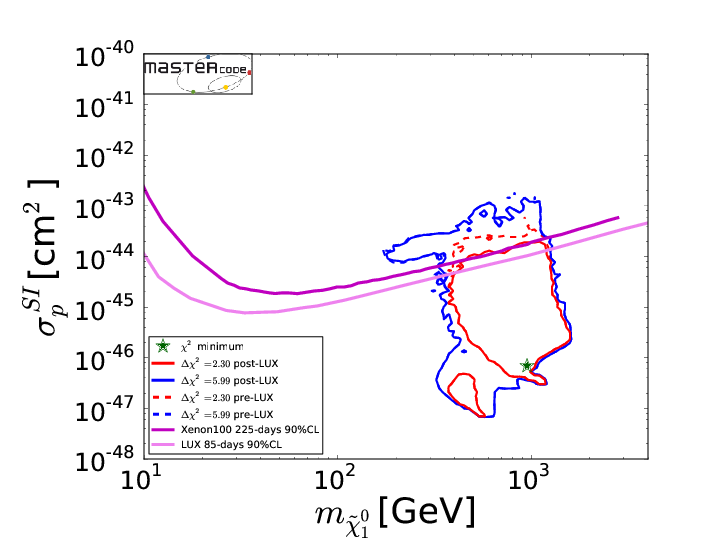
|
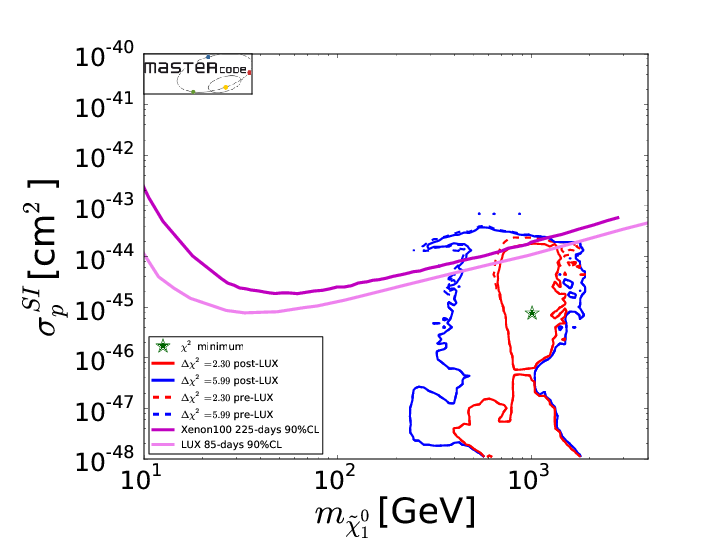
|
| The (mχ,σpSI) planes in the CMSSM (left panel) and the NUHM1 (right panel).
The Δχ2 = 2.30(5.99) contours, corresponding to the 68(95)% CL are coloured red (blue).
The solid (dashed) lines are for global fits including (excluding) the new LUX results. The new best-fit points are indicated by a solid green star.
The 90% CL exclusion lines of LUX and XENON100 are also shown. Note that the global fit contours include an additional systematic uncertainty on
σpSI. |
Implications of the first evidence of the Bs→μμ decay! [November 12, 2012]
After the
publication of the first measurement of the B
s→μμ branching fraction
by the
LHCb experiment,
we update our frequentist analysis of the parameter space of the CMSSM and NUHM1 models. The following results
are based on a (non-official)
combination of the ATLAS, CDF, CMS, and LHCb results yielding:
BR(B
s→μμ) ≈ 3.0
-1.1+1.2 x 10
-9.
The new measurement provides a valuable new constraint on the supersymmetric parameter space, but
the observation of a Standard Model-like branching fraction for the Bs→μμ decay is quite consistent with supersymmetry.
In fact, a Standard Model-like branching fraction of this decay was expected in constrained supersymmetric models like
the CMSSM or NUHM1 (see, e.g., the
recent MasterCode results for further details).
As a result, the favoured regions in the parameter space of these models do not change significantly after the inclusion of the new constraint.
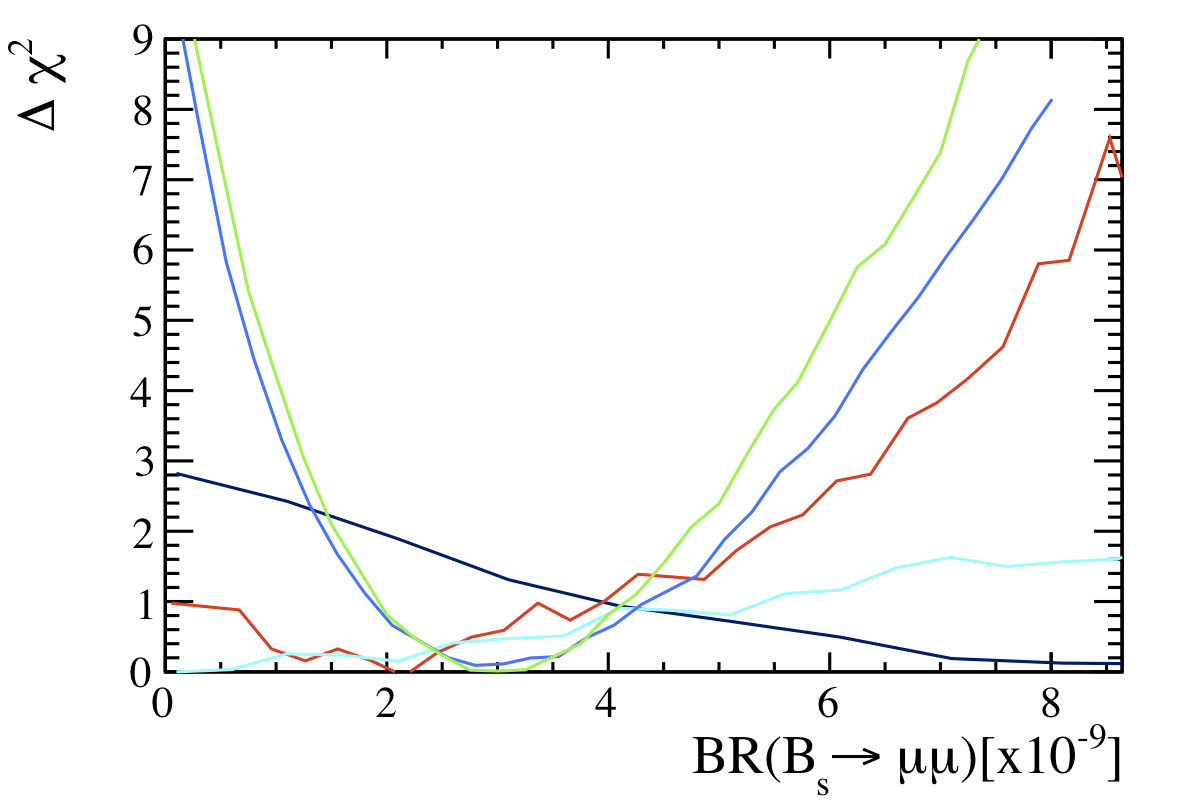
|
| Combination of BR(Bs→μμ) measurements: ATLAS (cyan, Winter 2012), CDF (dark blue, ASPEN 2012),
CMS (red, Winter 2012), LHCb (blue, HCP 2012). The combined likelihood is shown in green. |
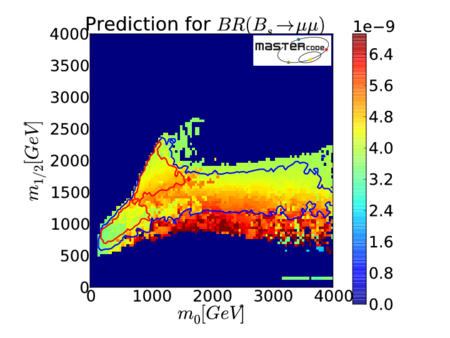
|

|
| Prediction for BR(Bs→μμ) in the (m0,m1/2) plane, in the (left) CMSSM and (right) NUHM1 models.
The red (blue) contour shows the 68% (95%) C.L. exclusion, after including the already published
constraints from the LHC and XENON100, as well as the new LHCb result. |
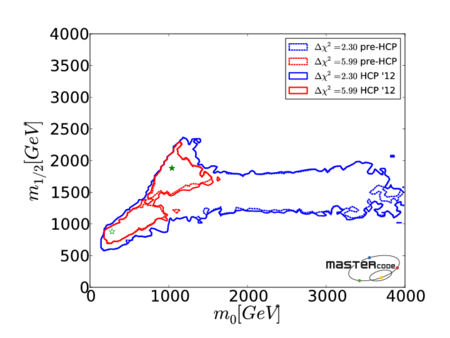
|
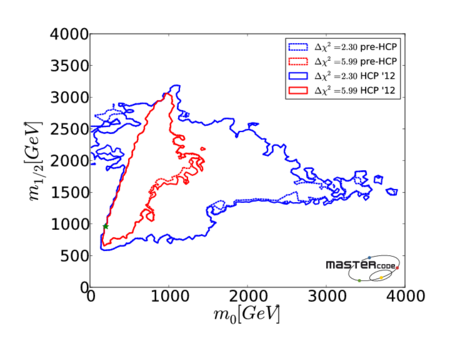
|
| 68% and 95% C.L. contours in the (m0,m1/2) plane, in the (left) CMSSM and (right) NUHM1 models.
The dashed lines include the already published constraints from the LHC and XENON100,
the solid lines include the new LHCb result in addition. |
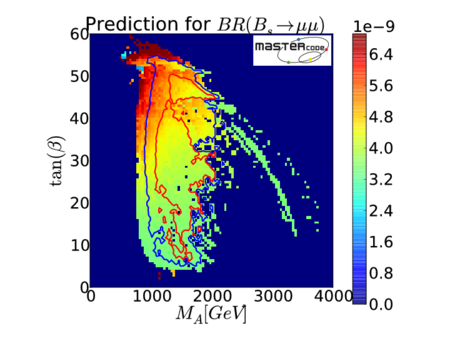
|
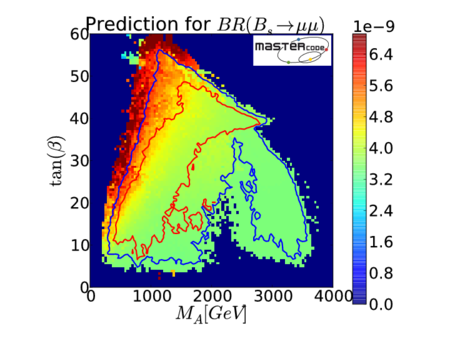
|
| Prediction for BR(Bs→μμ) in the (MA,tanβ) plane, in the (left) CMSSM and (right) NUHM1 models.
|
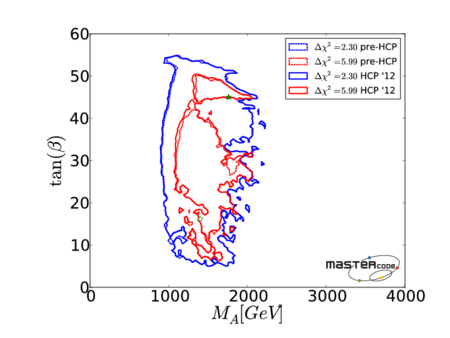
|
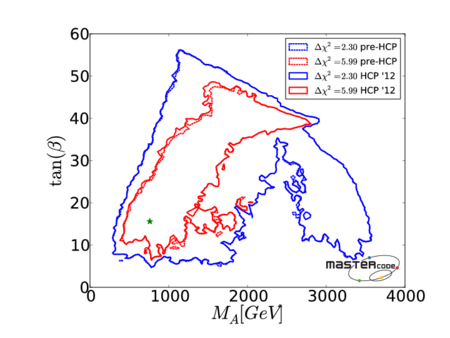
|
| 68% and 95% C.L. contours in the (MA,tanβ) plane, in the (left) CMSSM and (right) NUHM1 models.
|

|
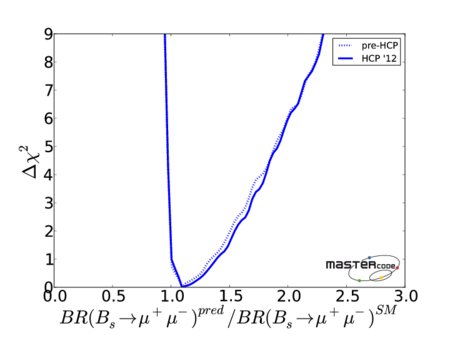
|
| Δχ2 distributions for BR(Bs→μμ) normalized to SM expectation in the (left) CMSSM and (right) NUHM1 models,
after (solid line) and before (dashed line) the new LHCb result.
|
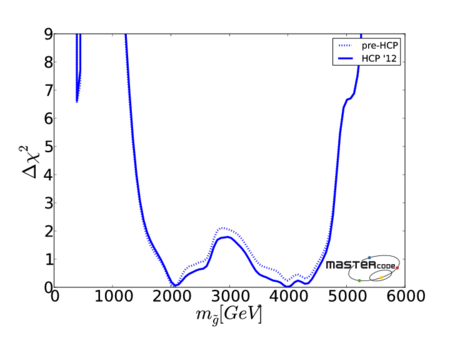
|
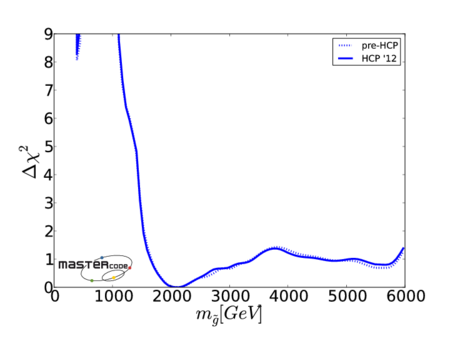
|
| Δχ2 distributions for the gluino mass in the (left) CMSSM and (right) NUHM1 models,
after (solid line) and before (dashed line) the new LHCb result.
|
Grand summary of 2011 searches [Summer 2012]
We make a frequentist analysis of the parameter space of the CMSSM and NUHM1, using a Markov Chain Monte Carlo (MCMC)
with 95 (221) million points to sample the CMSSM (NUHM1) parameter spaces.
Our analysis includes the ATLAS search for supersymmetric jets + MET signals using ∼5/fb of LHC data at 7 TeV,
which we apply using PYTHIA and a Delphes implementation that we validate in the relevant parameter regions of the CMSSM and NUHM1.
Our analysis also includes the constraint imposed by searches for B
s→μμ by LHCb, CMS, ATLAS and CDF,
and the limit on spin-independent dark matter scattering from 225 live days of XENON100 data.
We assume M_h ∼ 125 GeV, and use a full set of electroweak precision and other flavour-physics observables,
as well as the cold dark matter density constraint.
The ATLAS 5/fb constraint has relatively limited effects on the 68 and 95% CL regions in the (m_0, m_1/2) planes of
the CMSSM and NUHM1. The new B
s→μμ constraint has greater impacts on these CL regions, and also impacts significantly
the 68 and 95% CL regions in the (M_A, tanβ) planes of both models, reducing the best-fit values of tanβ.
The recent XENON100 data eliminate the focus-point region in the CMSSM and affect the 68 and 95% CL regions in the NUHM1.
In combination, these new constraints reduce the best-fit values of m_0, m_1/2 in the CMSSM, and increase the global
χ
2 from 31.0 to 32.8, reducing the p-value from 12% to 8.5%.
In the case of the NUHM1, they have little effect on the best-fit values of m_0, m_1/2,
but increase the global χ
2 from 28.9 to 31.3, thereby reducing the p-value from 15% to 9.1%.
More information:
→ The CMSSM and NUHM1 in Light of 7 TeV LHC, Bs→μ+μ- and XENON100 Data
New results including 1/fb of LHC data [October 11, 2011]
We update previous frequentist analyses of the CMSSM and NUHM1 parameter spaces to include the public results of searches for supersymmetric signals using
~1/fb of LHC data recorded by ATLAS and CMS and ~0.3/fb of data recorded by LHCb in addition to electroweak precision and B-physics observables.
We also include the constraints imposed by the cosmological dark matter density and the XENON100 search for spin-independent dark matter scattering.
The LHC data set includes ATLAS and CMS searches for jets + missing ET events and for the heavier MSSM Higgs bosons, and the upper limits on
B
s→μμ from LHCb and CMS. The absences of jets + missing ET signals in the LHC data favour heavier mass spectra than in our previous analyses
of the CMSSM and NUHM1, which may be reconciled with (g-2)
μ if tanβ ~40, a possibility that is however under pressure from heavy Higgs searches and
the upper limits on B
s→μμ. As a result, the
p-value for the CMSSM fit is reduced to ~15 (38)%, and that for the NUHM1 to ~16 (38)%, to be compared
with ~9 (49)% for the Standard Model limit of the CMSSM for the same set of observables (dropping (g-2)
μ), ignoring the dark matter relic density in both cases.
We discuss the sensitivities of the fits to the (g-2)
μ and b→sγ constraints, contrasting fits with and without the (g-2)
μ constraint,
and combining
the theoretical and experimental errors for b→sγ linearly or in quadrature. We present predictions for m
gluino, B
s→μμ,
M
h and M
A,
and update predictions for spin-independent dark matter scattering, stressing again the importance of taking into account the uncertainty in the pi-nucleon
sigma term, Σ
πN.
Finally, we present predictions based on our fits for the likely thresholds for sparticle pair production in ee collisions in the CMSSM and NUHM1.
More information:
→ Supersymmetry in Light of 1/fb of LHC Data
→ A selection of results
MasterCode's "red band plots" on the front page of EPJC! [September 6, 2011]
A figure of our
most recent paper, displaying the prediction for the lightest Higgs mass
in various constrained versions of the MSSM, was selected as a cover picture for
EPJC vol. 71, no. 8.
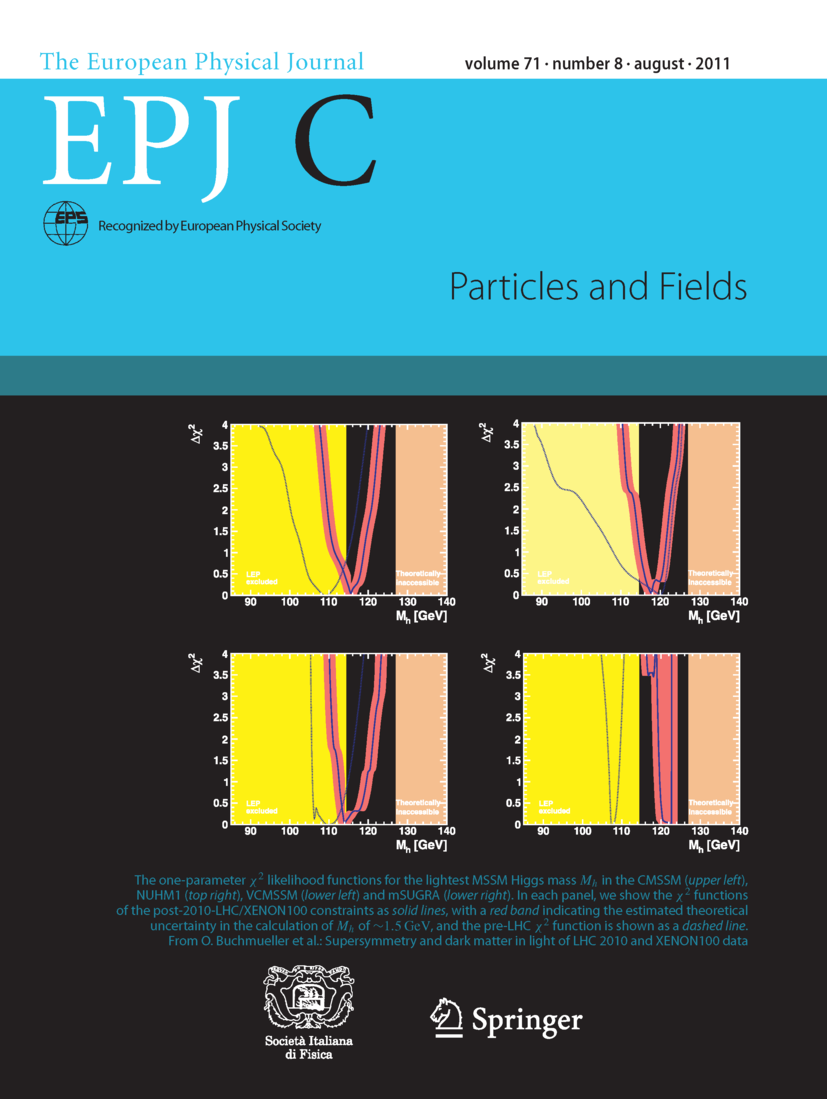
EPS 2011 update
The ATLAS and CMS Collaborations have recently presented at the EPS conference in Grenoble
(
http://eps-hep2011.eu/)
new results from more powerful all-hadronic SUSY searches, using about 1/fb of 2011 LHC data.
(
http://eps-hep2011.eu/) new results of their powerful
all-hadronic SUSY searches:
In addition, the CMS, LHCb, and CDF Collaborations have also presented stringent new limits
on the branching fraction for the B
s→μμ decay:
Here we incorporate this new information in an update of our recent frequentist global analysis
of the parameter spaces of the CMSSM and NUHM1:
arXiv:1106.2529 [hep-ph].
In that reference we incorporated a combination of the B
s→μμ constraints from LHCb and D0,
and also the previous CDF constraint, as well as the available LHC 2010 and XENON100 constraints,
as well as other observables including the LEP Higgs limit, b→sγ decay, g
μ-2,
the relic cold dark matter density, precision electroweak observables. Details of our analysis can be found there.
In the absences of official combinations of the new limits, we use in each case the single most constraining limit.
For the all-hadronic searches we use the CMS result up to m
0 = 1 TeV and the ATLAS limit
for m
0 > 1 TeV. In case of BR(B
s→μμ) we use the limit from LHCb.
We display first the (m
0, m
1/2) planes of the CMSSM (
Figure 1)
and NUHM1 (
Figure 2), showing best-fit points (green stars), 68% CL boundaries (red lines)
and 95% CL boundaries (blue lines). The dotted (solid) lines are before (after) including the new constraints
presented at EPS. To further illustrate the impact of the new limits on the allowed parameter space, we also
show in the same plotting format the correlation of the spin-independent dark matter scattering cross section with
the mass of the lightest supersymmetric particle (neutralino) in these models (
Figure 3 CMSSM
and
Figure 4 NUHM1).
In both models, the best-fit point changes significantly due to the tight constraints from the new direct
all-hadronic SUSY searches. The overall χ
2 increases from 26.2 to 30.2 in the CMSSM
and from 24.2 to 27.0 in the NUHM1, yielding a χ
2-probability of about
11% for the CMSSM and 17% for NUHM1.
The tension on the parameter space of these constrained SUSY models is more visible when
displaying the χ
2-probability in (m
0,m
1/2) planes. As can be
seen in
Figure 5, the CMSSM still exhibits a rather large region in the parameter
space with a goodness of fit probability of better then 5% (green region) but since the best fit
probability is only 11%, overall the portion of parameter space of this model still allowed possesses
only rather a low chi2 probability, as given above.
The situation is slightly better in the case of the less constrained NUHM1 (
Figure 6),
but also here the overall probability of 17% is also significantly lower than before the EPS conference.
Finally, we display the 1-dimensional χ
2 functions for B
s→μμ
in the CMSSM (in green,
Figure 7)
and NUHM1 (in purple,
Figure 8), showing the pre- (post-)EPS predictions as dotted (solid) lines.
We await with interest the results on the combination of B
s→μμ results and will update
arXiv:1106.2529 [hep-ph] more fully at that time.
The update will also discuss the impacts of different treatments of the g
μ-2 and b→sγ
constraints on global fits.
| Today: | |
| Yesterday: | |
| Last week: | |
| Last month: | |
| Total: | |
















